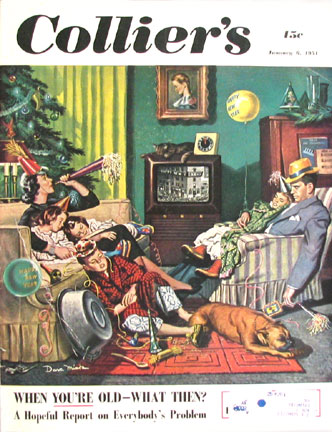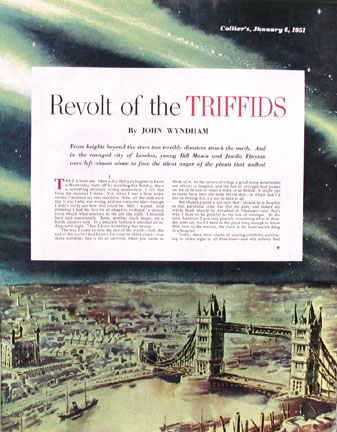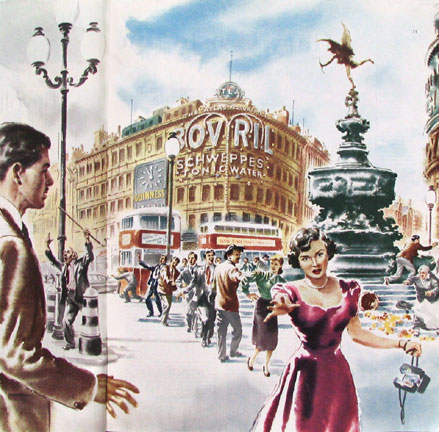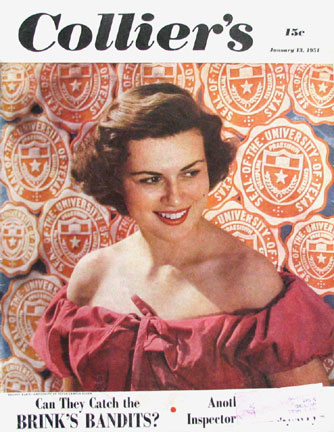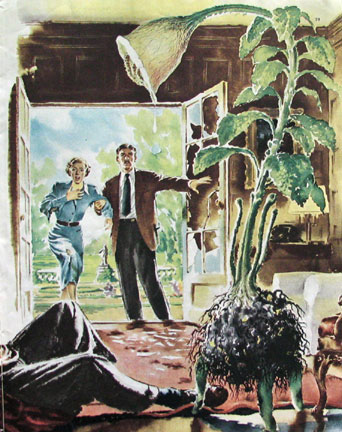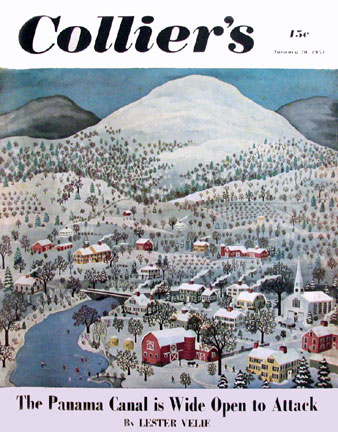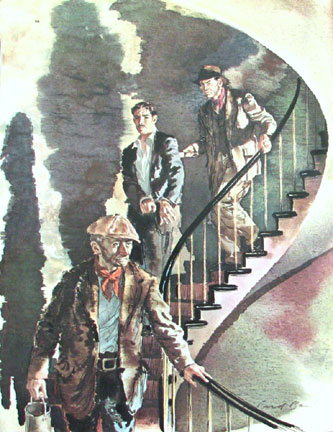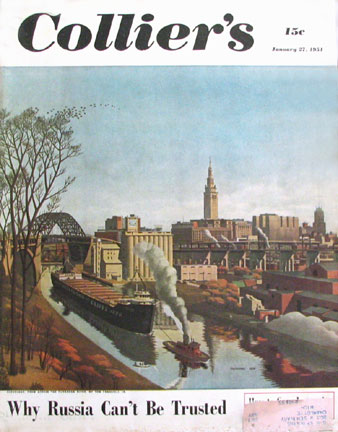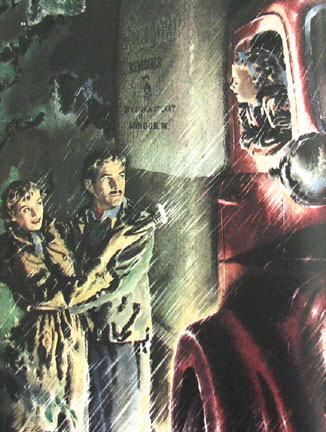John Wyndham
by Roger Russell
These
pages are copyrighted
No portion of this site may be reproduced in whole or in part
without written permission of the author.
John Wyndham Parkes Lucas Benyon Harris (1903-1969) wrote many excellent novels and short stories some of which were made into movies, radio drama and even a TV series. They were all published under various names John Benyon, Lucas Parkes, John Benyon Harris and Johnson Harris. He was born in Knowle, Warkickshire, England. His parents separated when he was eight and he and his brother Vivian spent their formative years in many different towns and boarding schools around England. After leaving school in 1921, he tried his hand at farming, law and advertising before settling on a career in writing.
His stories began appearing in pulp magazines in 1931 such as Amazing Stories. The themes included human nature (good and bad), the coexistence of intelligent species, the evolution of mankind and children gifted with unusual powers. After these prolific writings came the most remembered novels. The first and perhaps most famous was “The Day of the Triffids” published in 1951. The Popular Library paperback edition was published in the USA in March, 1952 and titled “Revolt of the Triffids.” I bought this book when it first came out. It was also published as a condensed five-part series in the weekly Collier’s magazine from January 6 to February 3, 1951 and was also titled “Revolt of the Triffids.” The magazines were fairly large, measuring 10-1/2” by 13-3/4”. Each issue contained text describing the chapter and also contained one picture with text describing the scene. Included is a picture of each magazine cover as well as one picture from the story
Part 1, January 6, 1951 (7 pages)
|
|
|
|
|
|
|
They moved in single file toward the center of Piccadilly Circus. The man in the lead caught at the girl’s arm |
|
Part 2, January 13, 1951 (6 pages)
|
|
|
|
|
|
Part 3, January 21, 1951 (7 pages)
|
|
|
|
|
|
Part 4, January 27, 1951 (7 pages)
|
|
|
|
|
|
Part 5 (conclusion) February 3, 1951 (7 pages)
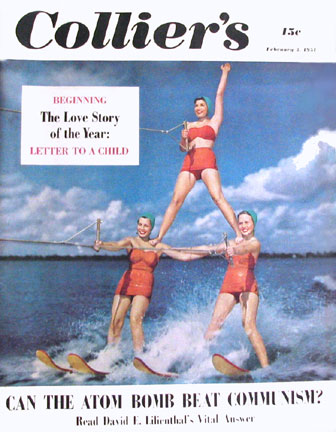
Like hideous parodies of men, the triffids walked closer and closer to the little haven Bill and Josella had created. The fight could not be avoided—and the weight of numbers alone gave the freakish plants the upper hand.
The picture in the last issue was 2-pages wide
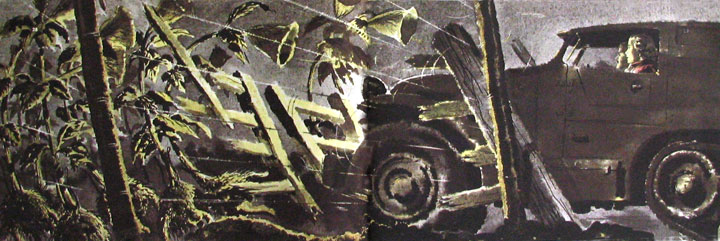
The half-track’s engine started at once. I slammed into low gear and drove straight at the gate. We plunged forward, knocking down half a dozen triffids while the rest slashed furiously.
![]()
 I did not learn about this story until 1952 when the
Popular Library book came out in March of that year and was available in the
book stores. The title was also “Revolt of the Triffids” and is shown at the
left. This was one of the best stories I had ever read.
I did not learn about this story until 1952 when the
Popular Library book came out in March of that year and was available in the
book stores. The title was also “Revolt of the Triffids” and is shown at the
left. This was one of the best stories I had ever read.
The story is described at the beginning of the book as follows:
“Man had mastered every animal in existence. But what about the new plant that had suddenly appeared everywhere—the strange, gigantic, terrifying Triffids? The Triffids could walk, and their hideous stingers killed in an instant—but they couldn’t see. As long as a man had eyes he could hold his own with them.
Then came that fateful Wednesday when the sky turned green with weird, celestial “fireworks.” Nobody wanted to miss the sight—and that was their doom. The green rays struck the world blind! Men, women and children stumbled about in darkness—and it was the day the Triffids took over!”
Maybe we all saw the 1963 movie with Howard Keel and Nicole Maurey. It ran for 95 minutes and was in color. It did not follow the original story very well at all. Steve Stekely directed the original material but the film was too short. The production was at the point where it might never be finished.
Then a second director, Freddie Francis, lengthened the film by integrating a scientist couple in a lighthouse who eventually discover that sea water would destroy the plants. This supplement was supposed to lengthen and add closure to the film, which made it digress even further from the original story that had an open ending.
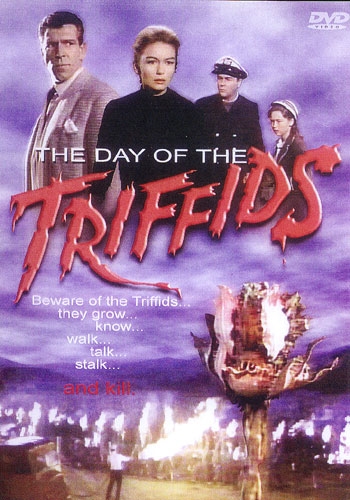
I saw the movie when it first came out in the theater. Many years later, I learned that the beginning of the movie was claimed to have been made at the Royal Botanical Gardens in London, also known as Kew Gardens. At least the part is accurate where the lights from the meteor showers are reflected in the glass-enclosed building called the Palm House. However, a search for credits for the movie did not mention the Gardens at all.

Today, Kew Gardens can be easily accessed by the underground lines.
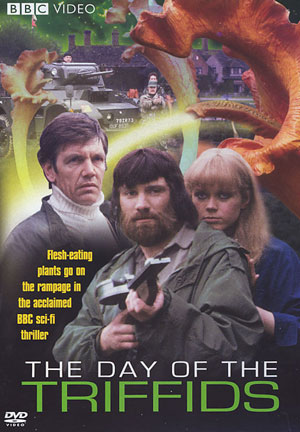 Fortunately, in 1983, The Day of the Triffids was
remade as a British TV miniseries with John Duttine and Emma Relph. This
followed the book much more closely and was most enjoyable. The total length
was extended to a total of 2-2/3 hours. The DVD cover is shown at the right. Because
I was so enamored by the original story, in my opinion the 1963 movie, although
entertaining, was a total disaster in comparison and really deserved a
different title.
Fortunately, in 1983, The Day of the Triffids was
remade as a British TV miniseries with John Duttine and Emma Relph. This
followed the book much more closely and was most enjoyable. The total length
was extended to a total of 2-2/3 hours. The DVD cover is shown at the right. Because
I was so enamored by the original story, in my opinion the 1963 movie, although
entertaining, was a total disaster in comparison and really deserved a
different title.
Many different portrayals of what the triffids might look like can be found in the different cover illustrations, posters and movie versions. Wyndham was working on a sequel to the movie titled “The Return of the Triffids” but he never completed it before his death in 1969.
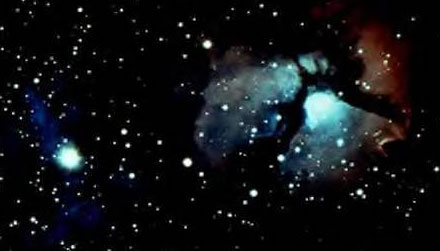 I often wondered where the name Triffid came from.
Some reference was made to the tri-pod-like “legs” but many years ago I found
that in astronomy there is a Triffid Nebula designated M20. It was named
Triffid because of the trisecting dark nebulosity in its center. It is located
in the constellation Sagittarius that is near M8, the Lagoon Nebula.
I often wondered where the name Triffid came from.
Some reference was made to the tri-pod-like “legs” but many years ago I found
that in astronomy there is a Triffid Nebula designated M20. It was named
Triffid because of the trisecting dark nebulosity in its center. It is located
in the constellation Sagittarius that is near M8, the Lagoon Nebula.
The University of Liverpool, supported by the Heritage Lottery fund, has acquired the archive of novelist John Wyndham. The archive consists of a virtually complete collection of manuscripts and typescripts (including unpublished works) and letters.
![]()

Simon
Clark has written a sequel twenty-five years later titled “The Night of the
Triffids.”
This is an excellent story and is highly recommended.
In the 29th year since the fall of the old world, David Masen, the now grown-up son of Bill Masen, wakes one morning to discover that the world has been mysteriously plunged into darkness. The few sighted people have their artificial lights, but once more the triffid has the advantage. Setting off to see the cause of the darkness, David finds himself stranded. Eventually rescued and taken to New York, he discovers a very different sort of colony: prosperous and technologically advanced. But all is not as it seems. This sophisticated society hides an evil secret—and David is about to come face to face with an old enemy from his father’s past.
![]()
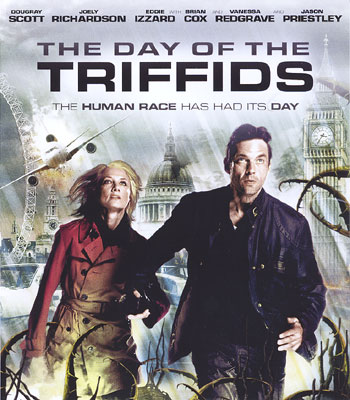
Here is yet another version that is a cut-and-paste assembly of the original “The Day of the Triffids” story plus some parts taken from Simon Clark’s “Night of the Triffids” and a few new creations. This new video from 2009 is intended to be a more contemporary update to the original story. Although some viewers may like it, in my opinion this remake is like so many other familiar movie formulas used today. Instead relying on the recreation of an old story, it would have been best left alone. So many science fiction movies today seem to belong more in the horror category.
![]()
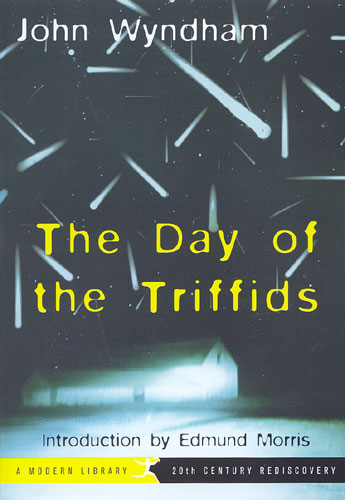
The story was released in book form yet again in 2003. It has 228 pages plus a six-page introduction by Edmund Morris and a reading guide.
![]()
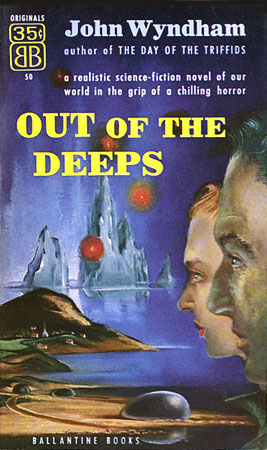 I was excited to find his second novel “Out of the
Deeps” that came out in 1953. It was also published in England under the title
of “The Kraken Wakes.”
I was excited to find his second novel “Out of the
Deeps” that came out in 1953. It was also published in England under the title
of “The Kraken Wakes.”
The story is described at the beginning of the book as follows: “First there were the fiery red balls plunging down from the sky into the sea. Then ships began to sink mysteriously. Then islands were attacked by beings, the like of which had never been seen before. But this was only the beginning of a relentless horror that was as difficult as it was to identify.
Mike and Phyllis Watson, reporters and broadcasters, were in on the matter from the start, since they saw the first evidence of it on their honeymoon. Through these two well-drawn and vivid characters, we watch the course of an invasion of our world that changes not only history and governments but the face of the earth itself.”
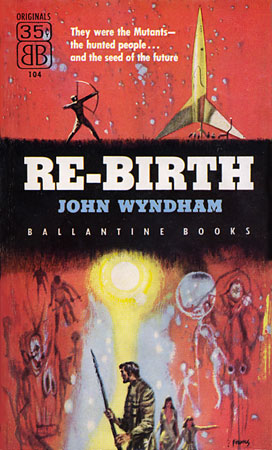
Then there came “Re-Birth” in 1955 and was published in England as “The Chrysalids.”
The story is described as: “Long ago, perhaps in the twentieth century, a terrible catstrophe had fallen upon the world. You could still see the blasted, charred cities—and the badlands where nothing grew at all.
But in the village where young David Storm lived, they were trying to rebuild the vanished civilization. It was a time of hard labor in the fields, and sharp terror in the night—when hideous raiding parties came out of the Fringes country. All this was part of life, but there were other things David could not understand.
….the freakish plants and animals that sprang unpredictably from sound stock…the babies that were born, and then never seen or mentioned again….the law that said a Mutant was an abomination—a thing to be hunted down and killed.
David tried hard to believe this, but he could not. Then one day he discovered that he too was a mutant outcast, that there were others—Rosalind and Mark, Petra and Anne—who shared this fearful heritage—and that their forbidden powers might mean a re-birth for mankind.”
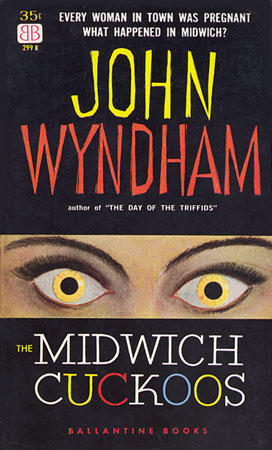 The Midwich Cuckoos was published in 1957. This was
also an exciting book to read.
The Midwich Cuckoos was published in 1957. This was
also an exciting book to read.
The place: Midwich—a sleepy English village virtually undisturbed since the time of William the Conqueror.
The place: Precisely 10:17 on the night of September 26th, when Midwich is surprised by strange visitors.
The result: Every woman in Midwich pregnant—the first signs of a strange and terrifying threat to the whole human race.
The movie Village of the Damned came out in 1960 and was based on the Midwich Cuckoos novel. It was 78 minutes long and starred George Sanders and Wolf Rilla.
The movie was remade in 1995 and ran 98 minutes as Children of the Damned with Christopher Reeve and Kirstie Alley. This movie did not follow the book as well.
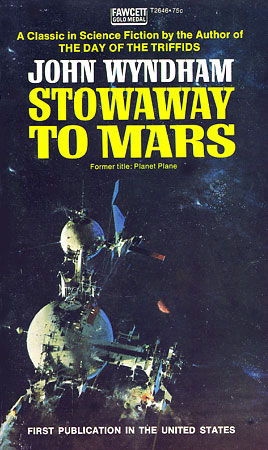 Stowaway to Mars was first published in 1935 and was
formerly titled Planet Plane under the pseudonym of John Benyon. The story
wasprinted in the USA in the 1972. The book described it as:
Stowaway to Mars was first published in 1935 and was
formerly titled Planet Plane under the pseudonym of John Benyon. The story
wasprinted in the USA in the 1972. The book described it as:
“The earth was holding a fantastic contest. An international prize of over a million dollars was being offered to the first man to complete an interplanetary journey. Target—Mars.
It was a race against time. The US, Russia and England were again competitors, fighting for fame and fortune.
Dale Curtance of England didn’t need the fortune. He was a millionaire. He was an eccentric. But most of all he was an adventurer and he was determined to win.
But winning was not going to be that easy. There were going to be many surprises. And they all began with the stowaway aboard Curtance’s ship. A stowaway to Mars. A Woman.”
 Another interesting story is The Secret People.
Originally published in 1935, was printed in the USA in 1973 by special
arrangement with the Estate of John Beynon Harris. It is described in the book
as:
Another interesting story is The Secret People.
Originally published in 1935, was printed in the USA in 1973 by special
arrangement with the Estate of John Beynon Harris. It is described in the book
as:
“It was the world’s greatest engineering feat—the flooding of part of the Sahara desert. But the new waters that covered up the land also threatened to destroy and ancient, secret civilization beneath the earth.
When Mark Sunnet’s plane crashed into the New Sea, he and his beautiful companion, Margaret Lawn, were taken prisoners by these secret people. They were taken deep beneath the earth into strange, dark caverns. Caverns that seemed to hold no hope of escape.
But Mark and Margaret had to escape. For now, suddenly, they were faced with two terrors—the secret people who were to be their executioners and the merciless New Sea that threatened to kill them all.”
Although many of Wyndham’s stories were written a long time ago, they portray human nature, both good and bad, and today are just as applicable as they were back then.
![]()
Other stories that I have found by John Wyndham are:
Chronoclasm, The
(1953)
Operation Peep (1951)
Perfect Creature (1953) originally published in The magazine of Fantasy
and Science Fiction.
Additional titles are as follows:
13 Great Stories
of Science Fiction 1960 (multiple authors)
A Sense of Wonder 1974 (multiple authors)?
Alfred Hitchcock Presents 1971 (multiple authors)
Angelico 1968
Best of John Wyndham, The
Chocky 1968
Chrysalids, The (also titled Re-Birth)
Consider Her Ways and Others 1956
Day of the Triffids, The (20th Century Rediscoveries)
Devil His Due, The 1969 (multiple authors)
Jizzle
John Wyndham Omnibus, The
Kraken Wakes, The (also published as Out of the Deeps)
Midwich Cuckoos
Moon Era, The 1967 (multiple authors)
Neutron Stars 1977 (multiple authors)
Out of the Deeps (also published as The Kraken Wakes)
Outward Urge, The 1959 first paperback
Plan for Chaos
Re-Birth (Also titled The Chrysalids)
Secret People, The
Seeds of Time, The
Sleepers of Mars
Sometime, Never; Three Tales of Imagination 1956
Spectrum 4 1969 (multiple authors)
Space Magicians, The (multiple authors)
Stowaway to Mars 1972
Tales of Gooseflesh and Laughter
Time Curve, The 1968 (multiple authors)
Trouble with Lichen 1970
Wanderers of Time 1973
Web
John H. Wyndham is not to be confused with John Wyndham the science fiction author. John H. wrote different kinds of books such as The Ultimate Freedom. He passed away in 1979.
|
Return to
Reader’s Guide to John Wyndham’s The Day of the Triffids
|
|
Are you ready to similarize yourself elsewhere? Be certain you have memorized your previous location to twenty decimal places within the last 26 hours. A wealth of information about Triffids and more links.
Created by Roger Russell |
